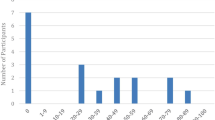Abstract
Web-based learning (WBL), the use of the World Wide Web as an arena for learning, has captured the imagination and interest of science educators worldwide. Although many educators believe in the unprecedented opportunities and potential offered by the Internet to enhance education, others are intimidated by its somewhat chaotic and unstructured nature. To enhance our understanding of WBL, it is important to categorize the main feature of the web as an educational medium: identify its instructional and pedagogical means, elaborate on the communication technologies and their implications, and define criteria to evaluate the content level. Following Nachmias, Mioduser, Oren, and Lahav (1999), this paper provides a classification scheme by which scientifically oriented educational websites can be evaluated and compared. The criteria are sorted into five dimensions. These dimensions are the (1) descriptive dimension (e.g., target population, site developers, language), (2) pedagogical dimension (e.g., instructional model, instructional means, cognitive demands), (3) representational dimension (e.g., representational structure and means, navigation tools), (4) communication dimension (e.g., links configuration, distant learning modes), and (5) scientific content dimension (e.g., content level, visualization means, historical background). Based on these criteria, we present an example of site evaluation in the field of atomic structure. Finally we discuss the potential embedded in this taxonomy to assist the web site developer, provide the science teacher with a tool for mindful selection and evaluation of scientifically instructional sites, and offer the researcher a conceptual framework for the formulation and study of relevant research questions.
Similar content being viewed by others
REFERENCES
Atkins, P.W. (1998). Physical Chemistry, 6th ed., Oxford University Press, Oxford.
Berenfeld, B. (1996). Linking students to the infosphere. T.H.E. Journal April: 76–83.
Berge, Z. (1995). Computer-mediated communication and the online classroom in distance education: from marks in the sand to computer conferencing via optics. In Berge, Z., and Collins, M. (Eds.), Computer-Mediated Communication and the Online Classroom, Hampton Press, Cresskill, New Jersey.
Berge, Z. L., and Collins, M. (Eds.). (1998). Wired Together: The Online Classroom in K–12, Hampton Press, Cresskill, New Jersey.
Chiappetta, E. L., Sethna, G. H., and Fillman, D. A. (1991). A quantitative analysis of high school chemistry textbooks for scientific literacy themes and expository learning aids. Journal of Research in Science Teaching 28: 939–951.
Chiappetta, E. L., Sethna, G. H., and Fillman, D. A. (1993). Do middle life-science textbooks provide a balance of scientific literacy themes? Journal of Research in Science Teaching 30: 787–797.
Cobb, C., and Goldwhite,H. (1995). Creations of Fire-Chemistry's Lively History From Alchemy to the Atomic Age, Plenum, New York.
Collins, M. (1995). Computer-mediated communication and the online classroom: Overview and perspectives. In Berge, Z., and Collins, M. (Eds.), Computer-Mediated Communication and the Online Classroom, Hampton Press, Cresskill, New Jersey.
Dede, C. (1996). Emerging technologies and distributed learning. The American Journal of Distance Education 10(2): 4–36.
Distributed Learning at the University of Central Florida. Available at: URL: http://pegasus.cc.ucf.edu/?distrib/dlucf/home.html
Encyclopedia Britannica, Vol. 2. (1970). Encyclopedia Britannica, Inc., New York: pp. 702–714.
Harasim, L. (1993). Collaborating in cyberspace: Using computer conferences as a group learning environment. Interactive Learning Environments 3: 119–130.
Harasim, L., Hiltz, S., Teles, L., and Turoff, M. (1995). Learning Networks: A Field Guide to Teaching and Learning Online, MIT Press, Cambridge.
Hackbarth, S. (1997). Integrating Web-based learning into school curriculum. Educational Technology, 37(3): 59–71.
Idhe, A. J. (1984). The Development of Modern Chemistry, Dover, New York.
Khan, B. H. (Ed.). (1997). Web-Based Instruction. Educational Technology Publication.
Mcquarrie, D. A., and Rock, P. A. (1991). General Chemistry, 3rd Ed, Freeman, New York.
Mioduser, D., Nachmias, R., Oren, A., and Lahav, O. (1999).Webbased learning environments (WBLE): Current implementation and evolving trends. Journal of Network and Computer Applications 22: 233–247.
Mioduser, D., Nachmias, R., Lahav, O., and Oren, A. (2000). Webbased learning environments (WBLE): Current technological and pedagogical state. Journal of Research in Computing in Education 33: 55–76.
Nachmias, R., Mioduser, D., Oren, A., and Lahav,O. (1999). Taxonomy of educational Websites-a tool for supporting research, development and implementation of Web-based learning. International Journal of Educational Telecommunications 5: 193–210.
Niaz, M. (1998). From cathode rays to alpha particles to quantum of action: a rational reconstruction of structure of the atom and its implications for chemistry textbooks. Science Education 82: 527–552.
Nye, M. J. (1996). Before Big Science-The Pursuit of Modern Chemistry and Physics 1800–1940, Prentice Hall International, New York.
Owston, R. D. (1997). The World Wide Web: a technology to enhance teaching and learning, Educational Researcher March: 27–33.
Petrucci, R. H., and Harwood, W. S. (1997). General Chemistry- Principles and Modern Applications, 7th Ed., Prentice Hall, New York.
Riel, M. (1993). Global education through learning circles. In Harasim, L. (Ed.), Global Networks-Computers and International Communication, MIT Press, Cambridge. Stanford Online: Available at: http://stanford-online.stanford.edu/
Stern, J. (2000). The design of learning software: Principles learned from the computer as learning partner project. Journal of Science Education and Technology 9: 49–65.
Teles, L. (1993). Cognitive apprenticeship on global networks. In Harasim, L. (Ed.), Global Networks-Computers and International Communication, MIT Press, Cambridge.
Tuvi, I., and Nachmias, R. Current state of Web based learning environments: focus on atomic structure (in preparation).
Venezky, R., and Osin, L. (1991). The Intelligent Design of Computer-Assisted Instruction, Longman, New York.
Whitten, K.W., Davis,R. E., and Peck, M. L. (1996). General Chemistry with Qualitative Analysis, 5th Ed., Saunders College Publishing, Fort Worth.
Author information
Authors and Affiliations
Rights and permissions
About this article
Cite this article
Nachmias, R., Tuvi, I. Taxonomy of Scientifically Oriented Educational Websites. Journal of Science Education and Technology 10, 93–104 (2001). https://doi.org/10.1023/A:1016624811912
Issue Date:
DOI: https://doi.org/10.1023/A:1016624811912




